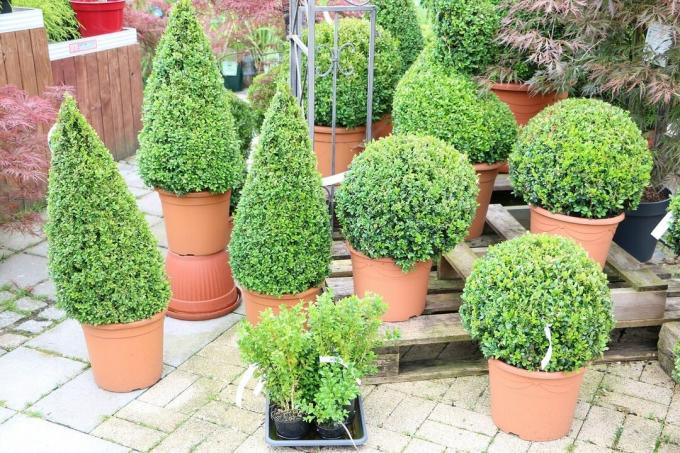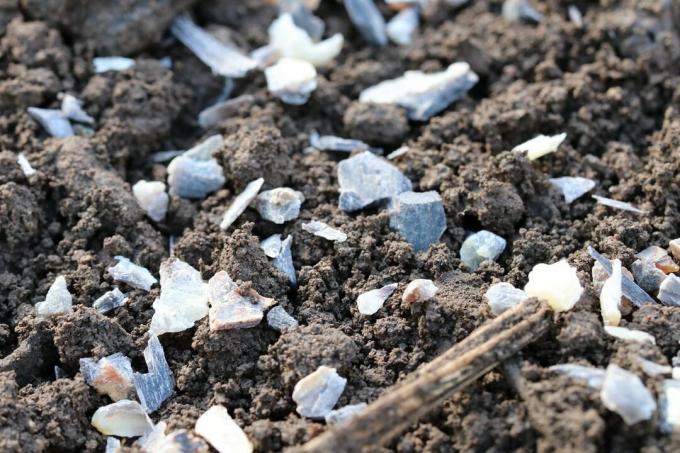
Table of Contents
- Boxwood
- Bare boxwood: causes
- 1. old
- 2. Missing cutting measures
- 3. Inadequate care
- 4. Pests
- 5. Diseases
- frequently asked Questions
Garden designers love boxwood. Dense hedges, attractive border borders and interesting topiary trees can be designed with the evergreen plant. What are the causes of balding from the inside? What can help against it?
In a nutshell
- various causes when boxwood becomes bald from the inside
- Balding possible by pests or diseases
- Missing or incorrect pruning measures impair dense growth
- old plants often shed
- powerful pruning can often help
Boxwood
70 types of boxwood are known worldwide. In Central Europe only the common boxwood (Buxus sempervirens) is native.
The light boxwood is very hard. Vessels were made from it centuries ago. Today the ornamental shrub can be found in many gardens. It is ideal for creating dense hedges. It also has a decorative effect when placed alone.

Bare boxwood: causes
However, a prerequisite for its attractive appearance is its dense growth. However, if the box tree suddenly becomes bald, there can be various causes:
1. old
Old box trees often show signs of fatigue. This age-related change has no major adverse effects on the shrub. However, an old box tree that is bare from below does not look particularly attractive.
You can also save an old box tree with a strong pruning.
2. Missing cutting measures
If the box tree is left to its own devices, it will lose its beauty and dense growth after a few years. The ornamental shrub should therefore be pruned at least once a year.
When cutting trees, only use clean, well sharpened cutting tool. If blunt knives, scissors or saws are used, bruises and cracks can occur, which form entry points for diseases. Keep in mind that every cut represents an intervention that the plant has to cope with. Straight, smooth cuts heal well and allow for quick recovery.

| Vigorous pruning of aged wood | Regular topiary pruning of well-kept trees |
|---|---|
| 01 Choose a dry day in spring when frosts are no longer expected. | 01 For the first topiary of the year, choose a dry day in April. At this time you will recognize the shoot and can take corrective action. |
| 02 Remove all stunted and older shoots. Leave only the young shoots. The younger shoots are not only more beautiful, they have more elasticity, sprout well and can be shaped better. | 02 First remove weak and dry shoots. Now shorten all the shoots by about ten centimeters. |
| 03 If necessary, you can carry out further contour cuts. There should be at least four weeks between the pruning measures so that the wood can recover well. The last cut should be done in September. |
Notice: While you can make gentle shape and care cuts all year round, a radical cut is between March and September prohibited by law.
3. Inadequate care
Basically, boxwood is very undemanding. It tolerates dry, sunny locations and can even handle polluted air on main roads.

In addition to regular pruning measures, the adequate supply of nutrients and a suitable location are also decisive. The ornamental wood prefers humus-rich, loose soils. You should therefore regularly supply the plant with organic fertilizers such as compost or Horn shavings. That increases the vitality. The specialist trade also has special box tree fertilizers ready. The robust plant only needs additional watering if it is long-term drought. As with all evergreen trees, it is important to water every now and then, even in winters with little rainfall.
4. Pests
If the box tree is balding from the inside, a pest infestation can also be the cause. The most feared pest of the beautiful wood is that Box tree moth (Cydalima perspectalis), a species of butterfly that immigrated from East Asia. The pest has no enemies in our regions and can therefore spread almost unhindered. Its larvae damage box trees. An infestation is often visible from the inside through the balding.
Instructions for combating:
- First collect visible caterpillars and destroy them.
- Sprinkle kieselguhr or algae lime on the infected trees.
- Wrap the boxwood in a black plastic bag in sunny weather.

Tip: After an infestation with the boxwood moth, a strong pruning can save the ornamental shrub.
5. Diseases
If the boxwood is balding, fungal diseases can be the cause. Quick help is then required. If you wait a long time, you risk irreparable loss of the plant.
Instructions for combating:
- Cut back the diseased wood vigorously.
- Water only in the root area so that the leaves stay dry.
Notice: Thoroughly disinfect the pruning tools after pruning diseased plants.
frequently asked Questions
The most effective help against balding is regular pruning. To prevent fungal diseases, which can only develop in moisture and warmth, we recommend thinning the plant thoroughly. In contrast, weekly spraying with a milk-water mixture can help to protect against fungi.
The larvae hatch in spring, when the temperature rises above ten degrees Celsius. You should therefore regularly check your box trees for caterpillars and visible webs from March onwards. Carefully collect the pests.
The yellow bars are ineffective in combating, but they can help to make the pest visible.
Usually a lack of nutrients is the reason for the lighter color. Provide your ornamental wood with compost. Special boxwood fertilizers are also available in specialist shops, which can be added to the irrigation water and optimally meet the needs of the plant.


